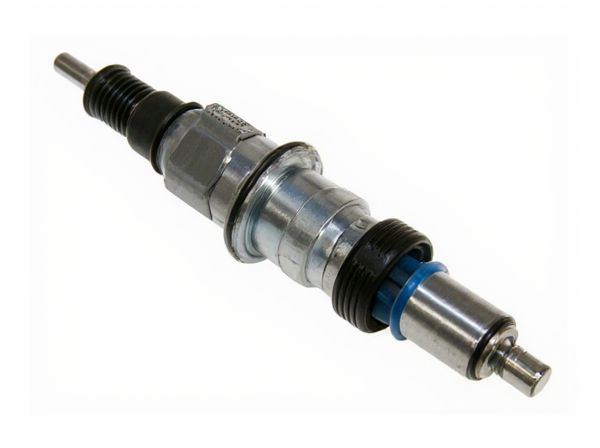
Photo illustration: Piezoelectric Injector vs Solenoid Injector
Piezoelectric injectors offer faster response times and more precise fuel control compared to solenoid injectors, resulting in improved engine performance and reduced emissions. Solenoid injectors use electromagnetic force to open the injector valve, which is less precise and slower than the piezoelectric mechanism. If you're seeking enhanced fuel efficiency and smoother engine operation, choosing a piezoelectric injector can significantly benefit your vehicle's performance.
Table of Comparison
| Feature | Piezoelectric Injector | Solenoid Injector |
|---|---|---|
| Operating Principle | Uses piezoelectric crystals to open and close injector valve rapidly | Uses electromagnetic solenoid to control valve movement |
| Response Time | Very fast (microseconds), precise fuel metering | Slower (milliseconds), less precise control |
| Fuel Efficiency | Higher due to accurate fuel delivery | Lower compared to piezoelectric injectors |
| Emissions | Produces lower emissions due to precise injection | Higher emissions due to less precise control |
| Durability | Longer lifespan but sensitive to fuel quality | Robust, better tolerance to poor fuel |
| Cost | Higher manufacturing and maintenance cost | Lower cost, widely used in older engines |
| Common Applications | Modern high-performance diesel engines | Conventional diesel and gasoline engines |
Introduction to Fuel Injectors
Fuel injectors, essential components in modern internal combustion engines, deliver precise amounts of fuel into the combustion chamber, optimizing engine performance and emissions. Piezoelectric injectors use piezo crystals to achieve rapid, accurate needle movements for finer fuel atomization and faster response times compared to solenoid injectors, which rely on electromagnetic coils to actuate the nozzle. The efficiency and precision of piezoelectric injectors often result in improved fuel economy and reduced emissions, making them a preferred choice in advanced gasoline and diesel engines.
Overview of Piezoelectric Injectors
Piezoelectric injectors utilize piezo crystals that change shape rapidly when voltage is applied, allowing precise control of fuel injection timing and quantity. They offer faster response times and finer atomization compared to traditional solenoid injectors, resulting in improved combustion efficiency and lower emissions. This advanced technology is commonly found in modern diesel engines, enhancing performance and fuel economy.
Overview of Solenoid Injectors
Solenoid injectors use electromagnetic coils to control the injection of fuel by rapidly opening and closing a valve, providing reliable fuel delivery at moderate speeds suitable for many conventional engines. These injectors are known for their cost-effectiveness, simplicity, and proven durability in automotive and industrial applications. While solenoid injectors respond slower than piezoelectric injectors, they remain a standard choice where precise fuel metering and lower system costs are priorities.
Working Principle: Piezoelectric vs Solenoid
Piezoelectric injectors operate using a piezoelectric crystal that rapidly changes shape when an electric voltage is applied, allowing precise control of fuel injection timing and quantity. Solenoid injectors rely on an electromagnetic coil to move a plunger that opens and closes the injector nozzle, controlling fuel flow based on electric current. The piezoelectric mechanism enables faster response times and finer fuel atomization compared to the slower mechanical movement of the solenoid injector.
Performance Comparison: Response Time and Precision
Piezoelectric injectors deliver faster response times, typically in the order of microseconds, compared to solenoid injectors, which usually operate in milliseconds, resulting in more precise fuel delivery and improved combustion efficiency. The high precision of piezoelectric injectors enables multiple injections per cycle, enhancing fuel atomization and reducing emissions. Solenoid injectors, while cost-effective and reliable, generally lack the rapid actuation and fine control found in piezoelectric systems, limiting their performance in high-demand modern engines.
Efficiency and Fuel Atomization
Piezoelectric injectors deliver superior fuel atomization and precise control over injection timing compared to solenoid injectors, resulting in enhanced combustion efficiency and reduced emissions. The rapid response and higher injection pressure of piezoelectric technology improve fuel spray characteristics, promoting better mixing with air and more complete fuel combustion. This leads to improved fuel efficiency and optimized engine performance in modern direct injection systems.
Durability and Maintenance Requirements
Piezoelectric injectors offer superior durability compared to solenoid injectors due to their precise electronic control, which reduces mechanical wear and extends the injector's lifespan. Maintenance requirements for piezoelectric injectors are generally lower as their components suffer less stress and deterioration over time, resulting in fewer replacements and adjustments. In contrast, solenoid injectors experience more frequent mechanical wear, requiring more routine maintenance and part replacements to ensure optimal performance.
Cost Considerations
Piezoelectric injectors generally have a higher upfront cost due to advanced materials and manufacturing processes, but they offer improved fuel efficiency and reduced emissions, potentially lowering long-term operational expenses. Solenoid injectors are more affordable initially and widely used in mass-market vehicles, yet they may lead to increased fuel consumption and maintenance costs over time. When evaluating cost considerations, the higher initial investment in piezoelectric injectors can be offset by enhanced performance and extended durability, influencing total cost of ownership.
Applications in Modern Engines
Piezoelectric injectors offer precise fuel metering and faster response times, making them ideal for high-performance diesel engines and advanced gasoline direct injection systems, enhancing fuel efficiency and reducing emissions. Solenoid injectors remain widely used due to their cost-effectiveness and reliability in conventional engines, suitable for standard intake and port fuel injection applications. Modern engines increasingly favor piezoelectric injectors in luxury and heavy-duty vehicles where enhanced combustion control is crucial for meeting stringent emission standards.
Future Trends in Injector Technology
Piezoelectric injectors offer faster response times and higher precision fuel delivery compared to solenoid injectors, making them ideal for upcoming gasoline direct injection and diesel applications aimed at reducing emissions and improving fuel efficiency. Future trends highlight an increasing adoption of piezoelectric injection systems driven by tightening environmental regulations and the demand for advanced engine performance in hybrid and internal combustion engines. Emerging technologies focus on integrating smart control algorithms with piezoelectric injectors to enhance real-time adaptability and optimize combustion processes.
 caratoz.com
caratoz.com